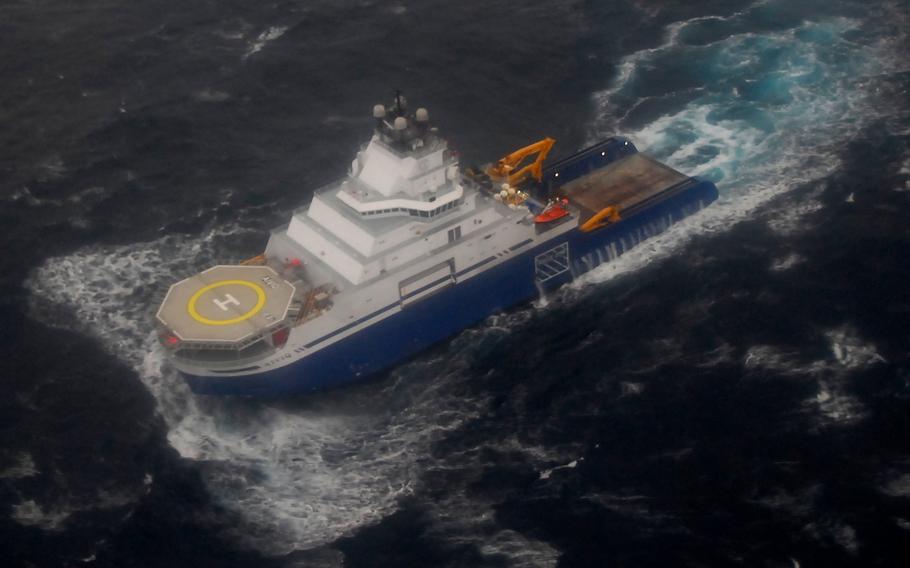
The tow supply vessel Aiviq travels through open water near Kodiak City, Alaska, in December 2012. (Chris Usher/U.S. Coast Guard)
The U.S. Coast Guard plans to hire a commercial icebreaker to serve in the Arctic while waiting for the next generation of its cutters to be built in the next several years, service officials told lawmakers.
Vice Adm. Thomas Allan, the deputy commandant for the Coast Guard’s mission support, told the House Committee on Transportation and Infrastructure’s subpanel on Coast Guard and maritime transportation on Nov. 14 that an icebreaking tug, the Aiviq, would be painted in Coast Guard colors and transferred from Pascagoula, Miss., to Juneau, Alaska. The Aiviq is scheduled to start icebreaking patrols in 2026.
“We are at least going to make sure we have a presence with that vessel,” Allan said.
The Coast Guard has two icebreakers. The USCGC Polar Star, launched in 1976, is usually committed to clearing sea routes around Antarctica. The USCGC Healy was only recently returned to service following a fire.
The addition of the Aiviq is meant to give the Coast Guard another option. At the same time, the U.S. is waiting for the first of 30 icebreaking ships, which were planned under a cooperative deal announced in November with Canada and Finland.
Plans now call for the Coast Guard to use the Aiviq on a contract basis, with a commercial crew. The cost of the deal is still under negotiation, the Coast Guard said.
The Aiviq would serve until three planned Polar Security-class icebreaking cutters become available. Construction of the first ship — to be named Polar Sentinel — is scheduled to start in 2025. The cost of the three ships would be $1.9 billion.
The Coast Guard originally planned to try to buy the Aiviq for $150 million as a permanent addition to its fleet. The ship now will be relinquished back to the commercial market after enough new cutters have been built.
“I don’t think we are looking to make tremendous investment on the vessel going forward,” Allan said.
But some lawmakers complained the Coast Guard plan would do little to close the “icebreaker gap” that the United States faces. Russia has at least 41 icebreakers, while China has dubbed itself an “Arctic adjacent” nation and has four in service.
Military and commercial activity in the Arctic region has increased in recent years as warmer seas have opened and enlarged sea lanes across the top of North America, Europe, and Asia.
Russia and China held joint naval exercises in October, with the flotilla passing through the Bering Strait just 12 miles from American waters in Alaska.
The Jamestown Foundation, a global security think tank in Washington D.C., has reported many Russian icebreakers are small or tied up clearing Siberian ports and river mouths.
However, some House lawmakers are worried about the imbalance in the number of icebreakers.
“In the Arctic, the Coast Guard projects American sovereignty,” said Rep. Daniel Webster, R-Fla., the subcommittee chairman. “It’s a region containing substantial resources that support a robust fishing industry, vast energy and mineral reserves, and new routes to facilitate maritime commerce. Given these immense resources, it should come as no surprise that adversaries, including Russia and China, are working to assert themselves.”
Allan and Vice Adm. Peter Gautier, the deputy commandant for Coast Guard operations, emphasized the joint building project as the key to Americans keeping pace with Russia and China in the future.
The Coast Guard plans to enlarge and modernize its base in Seattle to accommodate additional cutters and icebreakers, making the Puget Sound the homeport for operations in the Pacific Northwest and the Arctic.
A decision on how to enlarge the base will be made next month. The most expansive option would see the Coast Guard annex Terminal 46, a large commercial pier and warehouse area south of the Pike Place Market tourist attraction.
Rep. John Garamendi, D-Calif, a subcommittee member, told the Coast Guard officials that spending on icebreakers should match the American commitment to ground troops and air assets in blocking Russian and Chinese expansion in the Arctic region.
“Be bold,” he said.